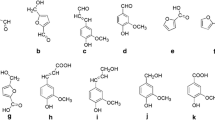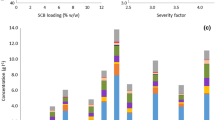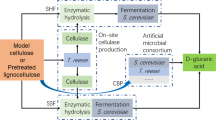Abstract
In the present preliminary study, we report results for the biocellulose nanofibres production by Gluconacetobacter xylinus. Production was examined by utilizing different feedstocks of single sugars and sugar mixtures with compositions similar to the acid hydrolyzates of different agriculture residues. Profiles for cell proliferation, sugar consumption, and the subsequent pH changes were thoroughly analyzed. Highest biocellulose production of 5.65 g/L was achieved in fructose medium with total sugar consumption of 95.57%. Moreover, the highest production using sugar mixtures was 5.2 g/L, which was achieved in feedstock with composition identical to the acid hydrolyzate of wheat straws. This represented the highest biocellulose yield of 17.72 g/g sugars compared with 14.77 g/g fructose. The lowest production of 1.1 and 1.75 g/L were obtained in xylose and glucose media, respectively, while sucrose and arabinose media achieved relatively higher production of 4.7 and 4.1 g/L, respectively. Deviation in pH of the fermentation broths from the optimum value of 4–5 generally had marked effect on biocellulose production with single sugars in feedstock. However, the final pH values recorded in the different sugar mixtures were ∼3.3–3.4, which had lower effect on production hindrance. Analyzing profiles for sugars' concentrations and cell growth showed that large amount of the metabolized sugars were mainly utilized for bacterial cell growth and maintenance, rather than biocellulose production. This was clearly observed with single sugars of low production, while sugar consumption was rather utilized for biocellulose production with sugar mixtures. Results reported in this study demonstrate that agriculture residues might be used as potential feedstocks for the biocellulose nanofibres production. Not only this represents a renewable source of feedstock, but also might lead to major improvements in production if proper supplements and control were utilized in the fermentation process.





Similar content being viewed by others
References
Yoshinaga, F. T., & Watanabe, K. (1997). Bioscience, Biotechnology, and Biochemistry, 61, 219–224.
Watanabe, K., Tabuchi, M., Morinaga, Y., & Yoshinaga, F. (1998). Cellulose, 5, 187–200.
Fontanam, J., de Souza, A., Fontana, C., Torriani, I., Moreschi, J., Gallotti, B., et al. (1990). Journal of Applied Biochemistry and Biotechnology, 25, 253–264.
Römling, U. (2002). Microbiological Research, 153, 205–212.
Rose, P., Mayer, R., & Benziman, M. (1991). Microbiological Reviews, 55, 35–58.
Tahara, N., Yano, H., & Yoshinaga, F. (1997). Journal of Fermentation and Bioengineering, 83, 389–392.
Naritomi, T., Kouda, T., Yano, H., & Yoshinaga, F. (1998). Journal of Fermentation and Bioengineering, 85, 598–603.
Dahman, Y. (2009). Journal of Nanoscience and Nanotechnology, 9(9), 5105–5122.
Toyosaki, H., Kojima, Y., Tsuchida, T., Hoshino, K., Yamada, Y., & Yoshinaga, F. (1995). Journal of General and Applied Microbiology, 41, 307–314.
Sani, A., & Dahman, Y. (2009). Journal of Chemical Technology and Biotechnology, 85(2), 151–164.
Bae, S. O., Sugano, Y., & Shoda, M. (2004). Journal of Bioscience and Bioengineering, 97, 33–38.
Chao, Y. P., Sugano, Y., Kouda, T., Yoshinaga, F., & Shoda, M. (1997). Biotechnology Techniques, 11, 829–832.
Chao, Y., Ishida, T., Sugano, Y., & Shoda, M. (2000). Biotechnology and Bioengineering, 68, 345–352.
Ishihara, M., Matsunaga, M., Hayashi, N., & Tišler, V. (2002). Enzyme and Microbial Technology, 31, 986–991.
Hestrin, S., & Schramm, M. (1954). Biochemical Journal, 58, 345–352.
Czaja, W., Romanowicz, D., & Brown, R. M. (2004). Cellulose, 11, 403–411.
Son, H. J., Kim, H. G., Kim, K. K., Kim, H. S., Kim, Y. G., & Lee, S. J. (2003). Bioresource Technology, 86, 215–219.
Bae, S. O., & Shoda, M. (2005). Journal of Microbiology and Biotechnology, 67, 45–51.
Qureshi, N., Saha, B. C., Hector, R. E., Huges, S. R., & Cotta, M. A. (2008). Journal of Biomass and Bioenergy, 32, 168–175.
Grohmann, K., & Bothast, R. J. (1997). Process Biochemistry, 32, 405–415.
Ezeji, T., & Blaschek, H. P. (2008). Bioresource Technology, 99, 5232–5242.
Matsuoka, M., Tsuchida, T., Matsushita, K., Adachi, O., & Yoshinaga, F. (1996). Bioscience, Biotechnology, and Biochemistry, 60, 575–579.
Keshk, S., & Sameshima, K. (2006). Enzyme and Microbial Technology, 40, 4–8.
Verschuren, P. G., Cardona, T. D., Robert Nout, M. J., De Gooijer, K. D., & Van Den Heuvel, J. C. (2000). Journal of Bioscience and Bioengineering, 89, 414–419.
Nakai, T., Tonouchi, N., Konishi, T., Kojima, Y., Tsuchida, T., & Yoshinaga, F. (1999). Proceedings of the National Academy of Sciences of the United States of America, 96, 14–18.
Weinhouse, H., & Benziman, M. (1974). Biochemical Journal, 138, 537–542.
Masaoka, S., Ohe, T., & Sakota, N. (1993). Journal of Fermentation and Bioengineering, 75, 18–22.
Embuscado, M. E., Marks, J. S., & BeMiller, J. N. (1994). Food Hydrocolloids, 8, 407–418.
Asai, T. (1968). Acetic acid bacteria: classification and biochemical activities. Tokyo: University of Tokyo Press.
Yang, Y. K., Park, S. H., Hwang, J. W., Pyun, Y. R., & Kim, Y. S. (1998). Journal of Fermentation and Bioengineering, 85, 312–317.
Velasco-Bedran, H., & Lopez-Isunza, F. (2007). Process Biochemistry, 42, 1180–1190.
Du Toit, W. J., Pretorius, I. S. (2002). Annales de Microbiologie, 52, 155–179.
Tahara, N., Tonouchi, N., Yano, H., & Yoshinaga, F. (1998). Journal of Fermentation and Bioengineering, 85, 589–594.
Tahara, N., Tabuchi, M., Watanabe, K., Yano, H., Morinaga, Y., & Yoshinaga, F. (1997). Bioscience, Biotechnology, and Biochemistry, 61, 1862–1865.
Park, J. K., Jung, J. Y., & Park, Y. H. (2003). Biotechnological Letters, 25, 2055–2059.
Suto, M., & Tomita, F. (2001). Journal of Bioscience and Bioengineering, 92(4), 305–311.
Forng, E. R., Anderson, S. M., & Cannon, R. E. (1989). Applied and Environmental Microbiology, 55, 1317–1319.
Canilha, L., Carvalho, W., & Almeida De Silva, J. B. (2005). World Journal of Microbiology and Biotechnology, 21, 1087–1093.
Sun, R., Lawther, J. M., & Banks, W. B. (1995). Industrial Crops and Products, 4, 121–145.
Acknowledgements
The authors would like to acknowledge Agriculture and Agri-Food Canada for the financial support. The contribution of Amir Sani is acknowledged with our appreciation together with the contribution of Casco Inc., London, Ontario, Canada.
Author information
Authors and Affiliations
Corresponding author
Rights and permissions
About this article
Cite this article
Dahman, Y., Jayasuriya, K.E. & Kalis, M. Potential of Biocellulose Nanofibers Production from Agricultural Renewable Resources: Preliminary Study. Appl Biochem Biotechnol 162, 1647–1659 (2010). https://doi.org/10.1007/s12010-010-8946-8
Received:
Accepted:
Published:
Issue Date:
DOI: https://doi.org/10.1007/s12010-010-8946-8




